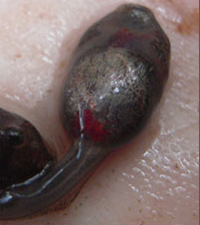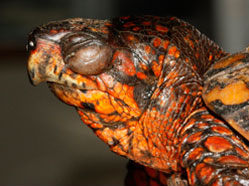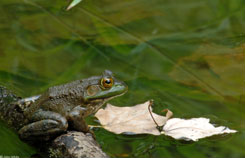Watching frogs metamorphose from tadpoles to frogs is an enriching
experience for children of any age. Many biological supply companies and pet
stores sell frog eggs and tadpoles just for this purpose. However, it is
important to understand that releasing tadpoles and frogs purchased online,
in a catalogue or in a pet store is a bad idea.
Non-native species
Several frog species available for purchase are not native to Maryland. This includes the popular grass frogs which are typically found in the
southern United States. While it is likely that many of these species may not survive in Maryland, those that do may outcompete our native frog
species for limited resources (like food) or, even worse, may harbor
diseases. For a list of frogs native to Maryland, please check out our frog page.

Purchasing frog species native to Maryland can also cause several
problems. For one, any purchased animal can harbor a potentially hazardous
disease. In addition, while the bull frog may be native, the genetics makeup
of bull frogs which are found in pet stores can be very different from that
of bull frogs found around Maryland.
Emerging Diseases
Releasing any frogs into the wild that have been purchased also comes
with the possibility of introducing emerging diseases like chytridiomycosis
or ranavirus.
Batrachochytrium dendrobatidis.
Chytridiomycosis has been linked to dramatic declines in populations of
amphibians in the western United States, Central America and South America.
It is believed that 30% of global amphibian populations have been affected
by the chytrid fungus, with some populations experiencing 100% mortality.
The oldest reports of chytrid fungus have been linked to the African
clawed frog, a popular frog found in the international pet trade. It is
believed that African clawed frogs as well as other amphibians exported for
the pet and scientific trades are responsible for the global transport of chytrid fungus. Many tadpoles sold by biological companies have been found
to be infected by the chytrid fungus. So, if any infected tadpoles are
released into the wild, then they can spread the disease
by the chytrid fungus. So, if any infected tadpoles are
released into the wild, then they can spread the disease
.
Ranavirus is another serious infectious disease that affects both
amphibian and reptile species. Ranaviral disease, infection and mortality
have now been reported on every continent except Africa. In Maryland, larval
wood frogs, spotted salamanders and marbled salamanders have experienced the
most mortality due to ranavirus. In addition, the eastern box turtle has
also been found to be affected by this virus. Similar to the chytrid fungus,
ranaviruses have been spread by the movement of infected animals through the
trade in amphibians for pets, food and research.
Alternatives to Purchasing Tadpoles
 One alternative to purchasing tadpoles online is to collect some of your
own. Legally, you are allowed to collect and possess 25 tadpoles of any one
species at one time. Look for tadpoles in a local stormwater management pond
or other small waterbody. Be sure to note where you found the tadpoles, so
you can release them back to the same site once they have metamorphosed.
One alternative to purchasing tadpoles online is to collect some of your
own. Legally, you are allowed to collect and possess 25 tadpoles of any one
species at one time. Look for tadpoles in a local stormwater management pond
or other small waterbody. Be sure to note where you found the tadpoles, so
you can release them back to the same site once they have metamorphosed.
To limit the spread of disease, always remember to sterilize aquaria and
dipnets prior to catching tadpoles. This can be accomplished by soaking nets
and aquaria in a 10% bleach solution for at least 10 minutes. After
sterilizing materials, rinse equipment with clean water. In addition, wash
hands thoroughly before and after handling any amphibians or reptile. This
precaution helps keep your germs from being passed to the animal or germs
from an animal you may have previously held.
While the tadpoles and frogs remain in your care, be sure to isolate them
from other animals, particularly any other amphibians or reptiles. Be sure
that the animals are healthy and disease-free before releasing them back
into the wild.
By collecting your own tadpoles from a local source, you can still enjoy
the educational aspects of watching the miracle of metamorphic animals while
also protecting local populations from the spread of disease. Additionally,
the educational experience can be greatly enhanced by allowing the students
to collect and release tadpoles and frogs.
Acknowledgements
Cope's gray treefrog tadpole by: John White
Tadpole with ranavirus by: Scott Farnsworth
Box turtle with ranavirus by: Scott Farnsworth|
Bullfrog by: John White